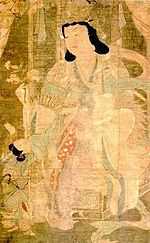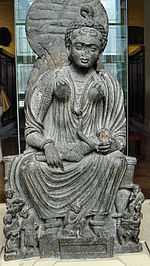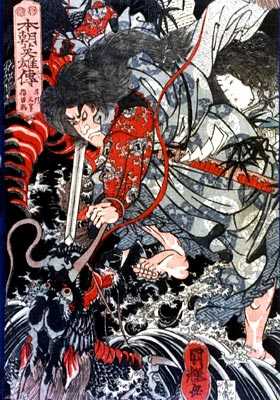Hariti

Hārītī (Sanskrit), also known as 鬼子母神 (Kishimojin), is a Buddhist goddess for the protection of children, easy delivery, happy child rearing and parenting, harmony between husband and wife, love, and the well-being and safety of the family.
Hariti-Kishimojin-Kariteimo is a figure of the 26th chapter of the Lotus Sutra, and is especially important to Nichiren Buddhism. In Shingon Buddhism, she is named Karitei (訶利帝) or Karitei-mo (訶梨帝母). Her iconography is based mostly on the Dai Yakusha Nyo Kangimo Narahini Aishi Jojuho.[1] In Japanese tradition, Kishimojin is an aspect of Kannon, the goddess of mercy, and she bears the epithets Kangimo, "Bringer of happiness", and Koyasu Kishibojin (子安鬼子母神) "Giver of Children and Easy Delivery". Women without children also pray to Kishimojin to help them become pregnant.

According to myth,[2][1] Hariti-Kishimojin was originally a rakshasi of Rajagriba at the same time that Gautama Buddha also lived there. She had hundreds of children of her own, whom she loved and doted upon, but to feed them, she abducted and killed the children of others. The bereaved mothers of her victims pleaded to the Buddha to save them. So, the Buddha stole Aiji, youngest of Hariti sons (in a variant version, the youngest daughter), and hid him under his rice bowl. After desperately searched for her missing son throughout the universe, Hariti finally appealed to the Buddha for help. The Buddha pointed out that she was suffering because she lost one of hundreds of children, and asked if she could imagine the suffering of parents whose only child had been devoured. She replied contritely that their suffering must be many times greater than hers. She then vowed to protect all children, and in lieu of children's flesh, she would henceforth only eat pomegranates. Henceforth Hariti became the protector of children and women in childbirth. In exchange, the Buddha gave her the enlightened knowledge of bodhi, which enabled her to withstand black magic and evil powers, and gave her the facility to cure the sick.
In the Japanese version of the tale, Kishimojin's enlists the aid of the Ten Demon Daughters (the Jurasetsu-nyo) to abduct and murder the children of other families. In some variants of the myth, the Ten Demon Daughters are themselves daughters (or daughters' daughters) of Kishimojin.[3] When Kishimojin accepts the Buddha's teachings, the Ten Demon Daughters do likewise.[1]
In the Kathmandu valley of Nepal, Hariti is also known as Hariti Maa ("Mother Hariti"), and her main temple is part of Kathmandu's Swayambhunath stupa complex. She is perceived as the consort of Pañcika and as protector of children, and is a patron of the Newar people of Kathmandu, Bhaktapur and Lalitpur. The Newar people also called her Ajima, meaning "grandmother" in Newari Language. In living Nepalese tradition, Hariti's eight oldest children are four pairs of twins, one boy and one girl each. These pairs are (first boy and girl: Dhanabhayu/Dhanamayju; second pair: Dilanbhaju/Dilanmayju; third: Laatabhaju/Laatimayju; fourth: Washibhaju/Washimayju). The boy Dilanbhaju is her favorite son.
References
| Wikimedia Commons has media related to Hariti. |
- ↑ 1.0 1.1 1.2 Schumacher, Mark (1995), "Kariteimo", A-Z Photo Dictionary of Japanese Buddhist Statuary, onmarkproductions.com.
- ↑ Coulter, Charles Russell; Turner, Patricia (2000), "Kishimojin", Encyclopedia of Ancient Deities, Jefferson: McFarland, p. 272, ISBN 0-7864-0317-9.
- ↑ Chitkara, M. G., ed. (2005), "Jurasetsu", Encyclopaedia of Buddhism, Glossary of Buddhism Terms, vol. XXI, New Delhi: APH Publishing, p. 218, ISBN 81-7648-184-X.
| |||||||||||||||||||||||||||||||||||||||||||||

